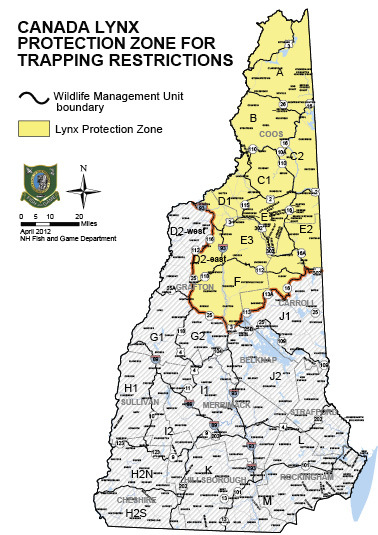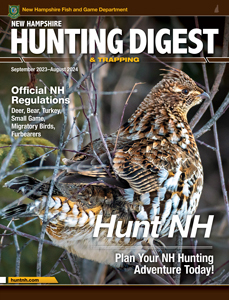Lynx Protection Zone & Trap Restrictions

Canada lynx are a federally listed Threatened Species. There is no open season for the trapping or hunting of lynx in New Hampshire. Fish and Game biologists have confirmed the presence of reproducing lynx in northern New Hampshire. To protect the lynx, and to help N.H. trappers avoid accidentally taking lynx, Fish and Game worked with the N.H. Trappers Association to delineate a lynx protection zone in the northern and White Mountains area where special regulations are in effect.
Statewide Restrictions
- No foothold trap with auxiliary teeth added shall be allowed.
- No foothold trap with an inside jaw spread greater than 6½ inches shall be set on land.
- Body gripping traps with an inside jaw spread greater than or equal to 6½ inches shall only be set:
- Five feet or more above the ground or surface of the snow with the exception of a snowstorm during the previous 24 hours; and
- In water for beaver or otter.
- There is no open season for taking bobcat, American marten, or Canada lynx. Any American marten or Canada lynx trapped must be reported immediately by contacting the Fish and Game Department at 603-271-3361 on business days during the hours of 8:00 a.m. to 5:00 p.m., during weekdays or 7:00 a.m. to 7:00 p.m. on weekends, or, if the Fish and Game Department is closed, by contacting the nearest Conservation Officer.
- Deadfalls are prohibited.
- Traps shall not be set within 50 feet of exposed bait, but may be set any distance from a covered bait (see definitions below).
- “Exposed bait” means bait that is the body of any animal, including fish, or parts thereof, including meat, organs, viscera, bones, or any other parts of an animal, that is visible from above, but does not include meat, organs, viscera, or bones totaling 4 ounces or less, or skin, hair, or feathers 25 square inches or less, droppings, urine, or living or dead animals held in a trap as the result of lawful trapping activity.
- “Covered bait” means bait that is the body of any animal, including fish, or parts thereof, including meat, organs, viscera, bones, or any other parts that are covered so as to not be visible from above, where cover includes, but is not limited to, brush, branches, leaves, soil, or snow and is constructed in a manner to withstand wind and normal environmental conditions. “Covered bait” includes baits less than one-half pound when placed in a dirt hole 6 inches in diameter or less at a depth of 6 inches or greater; and baits of less than 5 pounds placed on pole sets 5 or more feet above ground are also considered covered bait.
Restrictions within the “Lynx Protection Zone”
The following restrictions on traps shall apply while trapping in WMUs A, B, C1, C2, D1, D2-east, E and F:
- All foothold traps set on land must have one swivel in the chain/cable and one swivel connection to the trap;
- Body gripping traps with an inside jaw spread of 4 inches or greater and less than or equal to 5 inches which are set on the ground shall only be set as follows:
- Set in water at all times;
- Set under overhanging stream banks; and
- Set as a blind set with no bait or attractant; and
- Body gripping traps with an inside jaw spread 4 inches or greater which are set off the ground shall only be set as follows:
- Five feet or more above the ground or surface of the snow, with the exception of a snowstorm during the previous 24 hours;
- Affixed to a leaning section of a pole or tree, no greater than 4 inches in diameter that is free of branches and angled 45 degrees or greater in its entirety;
- Excluding branch removal, the pole or tree shall not have planed or altered sides.
- The area within 4 feet of the trap shall be free of trees, poles or other objects greater than 4 inches in diameter;
- The areas within 4 feet of the trap shall be free of trees or poles that are angled less than 45 degrees to the ground at any point between the ground elevation and the elevation of the trap; and
- The area within 4 feet of the trap shall be free of banks, bluffs, rocks or immediate rise in ground elevation;
- Body gripping traps with an inside jaw spread greater than 5 inches and less than 6½ inches which are set on the ground shall only be set:
- Recessed in the den entry of nuisance wildlife, with the den entry covered by wire mesh with openings that do not exceed 1½ inches side-to-side and wire gauge shall be 16 gauge or less or a wire diameter of 0.05 inches or greater.
- If placed in a lynx exclusion device, as follows:
- The trap jaws shall be completely within the device, the trap springs may be outside of the device;
- The lynx exclusion device shall not have an opening greater than 6 inches by 8 inches;
- The opening shall not be directly in front of the trap, but shall be either on the top or side of the device;
- The trap set within the device shall be a minimum of 18 inches from the closest edge of the opening to the trap;
- The back of the device shall be secured to withstand heavy pulling;
- If using wire mesh with a wood box, the wire mesh shall wrap around two opposite sides of the box and be secured;
- There shall be at least 2 attachment points for each side of the device where there is a joint, or where panels come together;
- The exclusion device shall be constructed of wood, or wire mesh that does not exceed 1½ inch openings from side to side;
- The wire gauge shall be 16 gauge or less or a wire diameter of 0.05 inches or greater;
- The opening slot in the device that allows the trap springs to extend outside the device shall be no more than 7½ inches wide and a height of no more than 1½ inches; and
- The trap shall be anchored outside of the device.
Know the difference between lynx and bobcat AND wolf and coyote. See our brochure at wildnh.com/hunting/publications.html.

